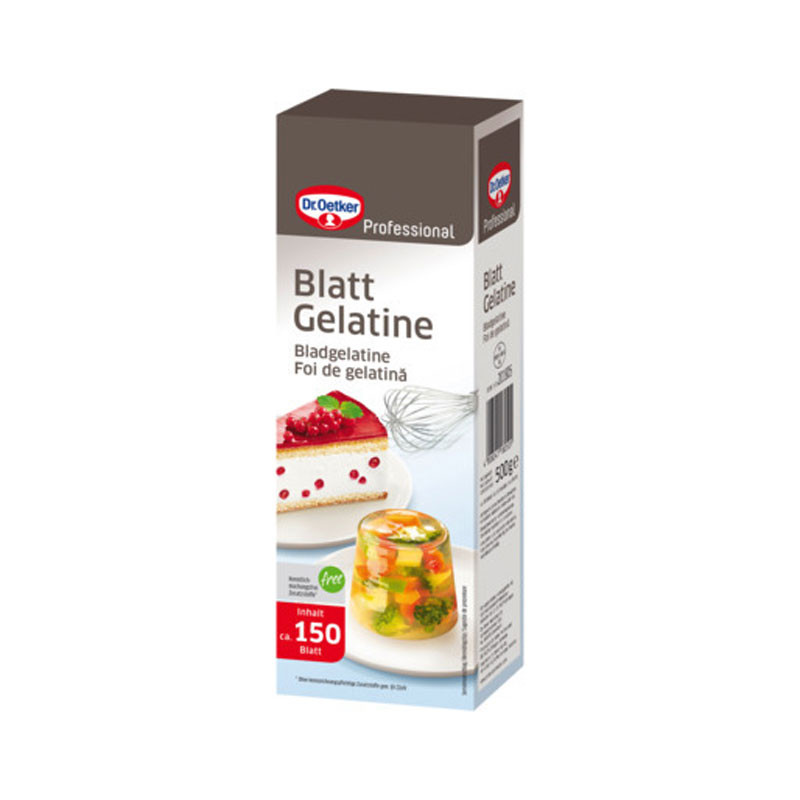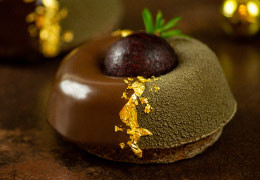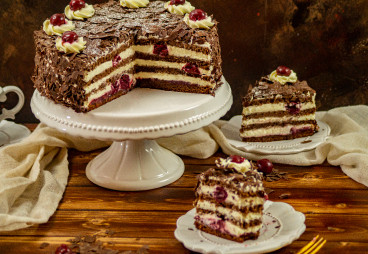

Order by 4 pm = delivery the next working day.
From CHF 100 purchase


Delicious cakes, sweet desserts and fine icings are given stability by gelatine. This leaf gelatine comes from the professional sector, the extra thin and large leaves soften quickly but do not dissolve in cold water. This allows you to achieve optimum results for all treats with gelatine.
Data sheet
Gelatine is an indispensable helper when it comes to making creams, fillings and icings. With the correct dosage and application, soft masses are created with sufficient stability to retain their shape in a cake, for example. Fruit jellies or even jelly babies can also be made with gelatine.
As it is of animal origin, it is sometimes replaced by vegetable gelling agents, but caution is advised with some recipes. Find out in advance about the melting or gelling point and the duration of the effect. Glazes in particular should be made with gelatine. At 25 to 35 °C, its solidification point is rather low, so the glazed cake or dessert will not be melted by the glaze. With plant-based gelling agents, the icing has less time to cool down and must be used immediately, which can lead to visual losses. In addition, the effect of some plant-based agents wears off after a few hours, which in the worst case could cause the cake to collapse.
To prevent lumps from forming in the cake filling or cream, you should know how to handle gelatine correctly. It must always be mixed and cannot simply be added to the cold cream. Prepare the cream in advance according to the recipe; whipped cream is often only folded into the mixture after it has been leveled.
Soak the gelatine leaves in cold water. For soft creams, use about 3 sheets per liter of liquid, for firm desserts you will need up to 8 sheets. This can of course vary depending on the other ingredients and the ambient temperature. After a few minutes, the leaves will be soft and collapsed. Remove them from the water, squeeze them and place the leaves together in a pan. If there is still a little water in the leaves, don't worry. Heat the gelatine slowly and stir with a whisk. If the gelatine is heated too much and starts to boil, it will lose its binding properties.
As soon as the gelatine has melted, pour a large dollop of your cream mixture into the pan and mix well with the gelatine. This mixture is then immediately poured back into the remaining cream and stirred in well. This process is called levelling, which prevents pieces of gelatine from forming in your cake fillings and creams.
| Energiewert in kJ | 1450 kJ |
| Energiewert in kcal | 341 kcal |
| Fett | 0.60 g |
| davon gesättigte Fettsäuren | 0.30 g |
| Protein/ Eiweiss | 84.00 g |
| Salz | 1.00 g |
| Kohlenhydrate | 0.00 g |
| davon Zucker | 0.00 g |
| Ballaststoffe | 0.00 g |
Allergens
 Vanilla cornet recipe
Vanilla cornet recipe
 Heart cake with vanilla and raspberry
Heart cake with vanilla and raspberry
 The perfect Christmas dessert
The perfect Christmas dessert
 The best Black Forest gateau
The best Black Forest gateau
 Making vanilla cream at home
Making vanilla cream at home

Delicious cakes, sweet desserts and fine icings are given stability by gelatine. This leaf gelatine comes from the professional sector, the extra thin and large leaves soften quickly but do not dissolve in cold water. This allows you to achieve optimum results for all treats with gelatine.